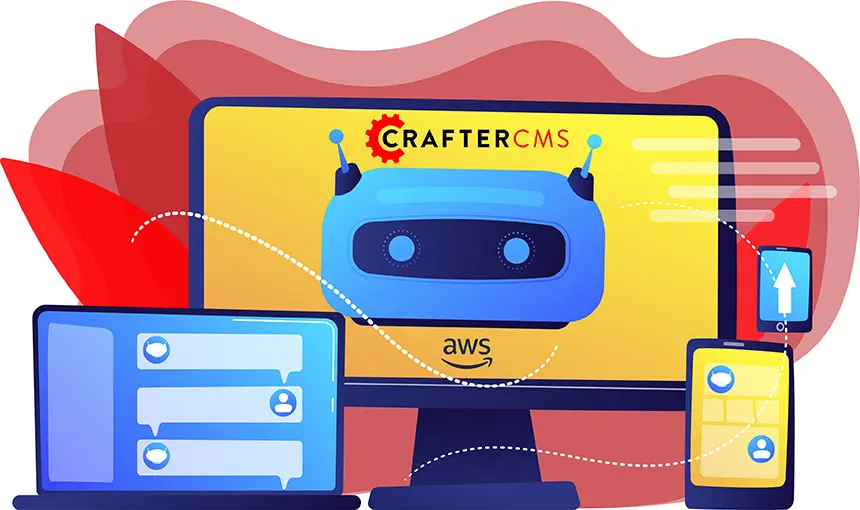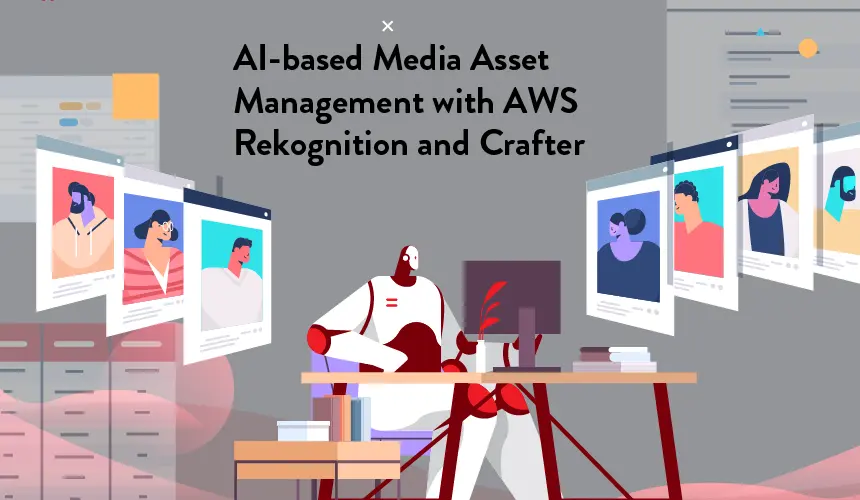Headless CMS Use Case: Building AI Chatbots on AWS

Mike Vertal

In today’s digital environment filled with an assortment of channels, brands are constantly on the lookout for ways to streamline their internal systems and serve their customers better. An emerging trend that helps brands achieve these two things is the chatbot. As artificial intelligence continues to filter into the work that enterprises do, chatbots have become key elements in improving the customer experience.
According to Statista, if chatbots are available for a business, 66% of millennials expect to receive 24-hour service. Another 45% believe that a chatbot will lead to a good customer experience.
Chatbots can provide several benefits for the organizations that choose to use them, but how can internal teams manage these chatbots? A headless CMS can enable marketers to manage the content in their chatbots and deploy them to multiple platforms. In this article, we’ll explain what you need to know about AI-powered chatbots and how you can use a headless CMS and AWS to build them.
What Is an AI Chatbot?
An AI chatbot is a software application that can simulate conversation with humans using natural language processing (NLP). These conversations can occur in a variety of places, from mobile apps to brand websites.
Chatbots have come a long way since the likes of PARRY and Jabberwacky. Many of these early iterations of chatbots relied on rules-based scripting programs, matching patterns to human inputs, and delivering responses. Now, with chatbots having the ability for human-like conversations thanks to NLP, they can leverage machine learning and be contained in portable devices like Alexa and Siri.
Types of Chatbots (And How They Work)
There are two primary types of chatbots: simple rules-based chatbots and AI/ML conversational chatbots. Hybrid options of these two types are also possible.
In the case of rules-based chatbots, there is a structured way for them to interact with a user. These chatbots can be deployed to complete simple tasks that don’t require conversational interaction with a user through scripted interactions that rely on menus, prompts, and keyword recognition.
On the other hand, conversational chatbots receive input from a user, analyze the request, identify the user’s intent and entities and then compose a reply. These types of chatbots are less restrictive than their rules-based counterparts and reflect the advancements made in chatbot technology.
Benefits of Chatbots
Chatbots can provide several benefits for the businesses that choose to use them. From round-the-clock availability to improvements to customer engagement and satisfaction. Chatbots can help organizations cut their expenses by automating business processes. Here are the benefits of chatbots:
24/7 availability
While traditional customer service representatives can only be available for a specific amount of time, chatbots offer continuous availability. Bots can process customer requests at all times and, if necessary forward responses they can’t answer to a human representative.
Omnichannel communication
Today, businesses strive to implement omnichannel strategies, providing their customers with the same high-quality experience across every digital touchpoint. With chatbots, it becomes easier to make that a reality since they can be accessed on multiple devices, whether a customer needs assistance on the website, mobile app, or while browsing on a tablet.
Reduced costs
One chatbot can support thousands of requests and essentially assist many customers at the same time. This enables organizations to redistribute their human resources to more intensive tasks, reducing the resources used.
How AWS Supports Building Chatbots
Amazon Web Services (AWS) provides a few services that provide the foundation for chatbots. First and foremost, this begins with Alexa, and its corresponding Alexa Skills Kit for building Alexa-powered chatbots and virtual assistants for your business.
AWS also provides a chatbot service via AWS Chatbot. For example, a user could use a system like Slack to send a command. An AWS Chatbot runs the command against an AWS service using the IAM role associated with the channel and returns a response to Slack. Amazon Lex is also available to enable developers to build conversational interfaces into applications.
In addition, AWS provides Amazon Transcribe, which automatically converts speech to text, enabling audio to be converted to text for use by applications, and Machine Learning on AWS.
While AWS provides the technical foundation for creating chatbots, internal users still need to be able to manage these bots. For that, marketers and developers can use a headless CMS.
Managing AI Chatbots With a Headless CMS
Chatbots produce content, and non-technical users need to be able to manage content. AI chatbots, in particular, are omnichannel and can be accessed on various channels and via several different mediums, whether text, voice, or video. A headless CMS enables organizations to manage content and deliver it to these different channels by using APIs.
Crafter has built an open source Alexa blueprint and a headless CMS-powered Alexa demo site for easily getting started with building and managing conversational content with your very own Alexa chatbot.
Not only can a headless CMS be used to manage chatbots, but you can also manage headless CMS workflow using a chatbot. These bots can allow you to perform all content reviews and publishing through a Slack channel without going into the CMS.
A platform like CrafterCMS provides headless+ CMS capabilities that don’t limit you to content delivery. It also provides a developer-friendly and powerful scripting platform. Using the blueprint described above, developers can easily deploy backend solutions to support Alexa Skills. When building Alexa Skills, requests must be received in a specific JSON format and that responses be returned in a particular format. CrafterCMS enables this while also providing personalization support, easy integration with AWS Services and enterprise services, and more.
CrafterCMS: Powering AI Chatbots With AWS
For businesses that want to enhance the customer experience, chatbots allow them to interact with their customers 24/7 across multiple channels without draining resources. With a headless+ CMS like CrafterCMS supported by AWS, developers can quickly build these chatbots using any language and framework they choose. At the same time, marketers have the user-friendly tools they need to manage the content.
CrafterCMS also removes the friction that can sometimes occur when developers and content authors work together in a CMS through its unique support for DevContentOps methods. By bringing content operations and the CMS into the traditional DevOps process, organizations can continue to build innovative content applications faster than ever before.
If you want to get up and running quickly with building chatbots in CrafterCMS, blueprints are available on GitHub and in the Crafter Marketplace that can help streamline the process. For a demo and to learn more about how chatbots work with a headless CMS, see our webinar: Building AI Chatbots with a Headless CMS on AWS.
Related Posts

Websites Are Dead?

Mike Vertal

No-Code Experience Building for Marketers & Designers

Amanda Lee

Is Your CMS MACH-Ready? A Practical Guide for Enterprise Architects

Sara Williams

Composable DXP vs Traditional DXP: Why Enterprises Choose CrafterCMS

Amanda Jones
Related Resources
-

CrafterCMS at eBay: The Universal Content Platform for eBay.com
Webcast
-

Personalized Digital Experiences for a Cruise Liner
Webcast
-

Introducing CrafterCMS v4.0
Webcast
-

Modernizing Video Delivery and Content Management at CPAC, A Canadian Nationwide Broadcaster
Webcast
-

AI-based Media Asset Management with AWS Rekognition and CrafterCMS
Webcast





